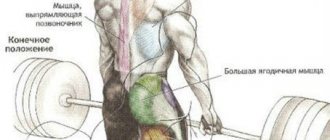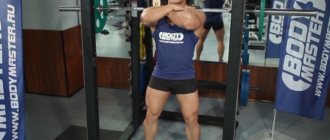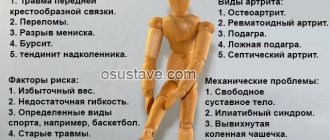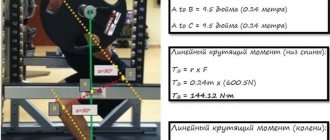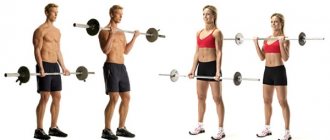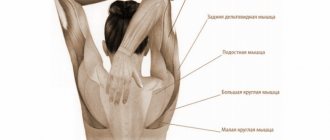Why does my lower back hurt after squats with a barbell?
There are 3 positions of the lower back in which it is located during a squat:
- A – when the lower back is convex
- B – when the lower back is straight
- C – when the lower back is concave
When you hold a barbell with a decent weight, and even with an average one, a convex lower back is like a high-risk nuclear reactor with a broken safety system that can fire at any moment.
The straight state of the lower back is safe and does not have a special effect on strength indicators.
A concave lower back, in the lowest phase of the movement, is also dangerous, since the load on the vertebrae of the lower back increases due to the arching of the spine, you bend it, causing a critical load.
The correct execution option would be when you lower yourself with a slightly convex lower back, and in the ascent phase, literally after 5 cm, it goes into a straight position. To learn this, stand sideways to the mirror, take an empty bar and practice, it may take you more than one week, but a healthy lower back is more important.
A slight rounding prevents the lower back from becoming concave; this is a very important point in squats and deadlifts. Believe me, a healthy lower back is better than pumped up muscles.
Each of us has small flaws in bone tissue, they cause discomfort in movement and even lead to pain in the joints, while others do not experience anything similar when performing the technique.
To eliminate this shortcoming, try different stances, change the position of your legs, don’t forget squats in the Smith machine, if that doesn’t help, try large weights and dumbbells for squats, only, of course, your arms will be along your body. For those who are tall, pay attention to developing flexibility in the ankle joint, this may be a key solution to the problem.
When the back of the thigh has a low degree of flexibility, in order to lower the barbell into the desired position, the pelvis begins to deviate from the correct range of motion. At this time, the constrained thigh muscles do not allow the pelvis to take the correct position, they hold it, at this time the lower back does not straighten and becomes convex.
To solve this problem, pay attention to stretching exercises; you can also use squats with a barbell on straight arms and with a kettlebell.
These 2 exercises make it possible to squat with the correct trajectory, when the back is straight, the hips move apart, the hamstrings stretch, which improves its flexibility, and the lower back is able to be in an even position.
For those who are new to working with weights, squat with a kettlebell; straight-arm squats with a barbell are more suitable for experienced athletes.
How to squat without back pain
The lumbar region of the back can hurt for various reasons.
Here are the main ones:
- Muscle pain. As a rule, in the case of squats, this is a nagging pain in the lower back.
- Manifestations of osteochondrosis of the lumbar spine.
- Pinched nerve.
- Intervertebral hernia.
- Consequences of hypothermia.
Next, we will analyze each case and tell you what to do if your back hurts in each of the options.
Muscle pain
When your lower back starts to hurt after a squat, we say this: you pulled your back, or tore it off. In fact, if we are exercising for the first time or if we have given too much load, the lumbar region of the back will hurt in 90% of cases. Also, if you haven’t warmed up your lower back enough, which is most often the case, long-lasting pain will appear.
The discomfort will continue for 2-7 days, depending on how much the muscle has been overworked.
With proper squat technique, your lower back should not hurt much.
If you have muscle pain (you will understand when it is a joint and when it is a muscle), use warm baths and pain-relieving ointments. Follow the instructions included with the ointments. Ask someone to knead the sore muscle with their hands, it will hurt, but it is necessary! If the pain is not too severe, you can do a set of hyperextension as a warm-up to get the blood flowing in the aching muscle.
If the pain intensifies, and a bruise or yellowness has formed on the lower back, it is better to consult a traumatologist.
Usually the area that hurts is from the tailbone to the bottom of the chest.
Osteochondrosis
For osteochondrosis, it is recommended to squat with light weights and strictly in a special belt. We recommend using an orthopedic belt with solid stiffeners instead of athletic belts. Your spine needs additional support.
You can find out which belt you need from a doctor at any ultrasound center in your city. At the same time, clarify the diagnosis.
If you have a sore lumbar region, you should especially not tilt or round your back while squatting. Be careful not to let the bar pull you forward. To do this, spread your legs wider. Remember the sumo deadlift? The wider the legs, the smaller the range of motion in the lower back. It's good for your back.
By the way, by improving your technique, you reduce to zero all the risks of aggravating the situation with your back.
With osteochondrosis, you may feel sharp pain during back exercises. More often, it happens that discomfort occurs the next day or within 12 hours after training. You cannot bend without pain, it is difficult for you to sit for a long time, because the pain intensifies.
What to do? While you have acute pain, avoid stress on your back. It is better not to go to the gym at all until the pain subsides. You need to see a neurologist, or visit an ultrasound center, where they will advise you on the right orthopedic belt. The latter will become your best friend for life.
Doctors may prescribe pain-relieving injections or special vitamins for the nervous system. Then, when the pain subsides, you can start training. And be careful - pay attention to any discomfort. And don’t listen to coaches who convince you to ignore all these precautions. They are not doctors and never have been. And, if anything happens, it will be your back that will hurt, not theirs.
Pinched nerve
It happens suddenly and instantly. You just did a normal rep. And then a sharp pain, and now you can barely walk. Sometimes pinching occurs at the bottom of the squat and you are unable to stand up. Well, if you worked at Smith, you can put the barbell on the nearest block. What about the barbell if you're not at Smith? And if there are no insurers?
Throw it back. If there are people behind you, warn them so that no one gets hurt. Then be guided by the circumstances.
If you cannot walk, or do it with difficulty, call emergency medical help directly to the gym.
Most often what happens is that the pain during exercise is not so severe that it prevents you from walking home. But in the evening or the next day it worsens so much that you cannot move. In this case, you also need to call for help. It is necessary for doctors to relieve pain and eliminate pain problems.
Why did this happen:
- You had a hernia and it pinched a nerve.
- You have rounded your back
- You took on too much weight, causing your exercise technique to suffer.
There should be no self-medication here. Only qualified medical care.
If there is a hernia, we recommend that you examine it thoroughly. You need to know everything about it so that you can understand how to exercise in the gym. And is it possible to do this at all? We recommend that you consult a sports doctor.
If a person with a hernia experiences back pain from squats, you need to try different options: from losing weight to changing the variation of the exercise (maybe you should switch to a Smith machine).
Treatment is carried out according to indications. If you have found your individual way of squats, you have no pain - everything is fine, do it. Just check your hernia regularly for changes.
Hypothermia
The cold may or may not be related to the gym.
Most often, in the gym, sweating, you can get caught in the cold air from the air conditioner. At risk are girls who like to expose their lower back.
Exposure of bare skin to cold can cause inflammation of the spinal nerves. It's very painful. Pain will appear within 12 hours of exposure to cold.
However, most often, pain after a cold has nothing to do with the gym; it is a consequence of a careless attitude towards your health.
Inflammation is treated on an outpatient basis, but sometimes you need to go to the hospital for a week for better treatment.
Let's look at the main mistakes or negligence that lead to back pain after a squat.
- The legs are set narrowly. With this placement of the feet, the back is forced to bend strongly forward. It turns out that when standing up, the weight is pushed not by the legs, but by the back. It turns out that this is not a squat, but some kind of strange deadlift. Feet should be spread wide. At the same time, do not forget to spread your socks to the sides, as well as your knees.
- The barbell is located not on the back muscles, but on the neck. In this case, you also risk developing cervical osteochondrosis. Squatting with a barbell around your neck is also dangerous because the load on your lower back will increase significantly.
- You kept your head down during the exercise. That is why such mistakes should not be made. Your gaze should always be straight while squatting. If you bend your neck, it affects your entire spine. Including on the lower back.
- You don't warm up well. Always stretch your lower back well. Pull it.
- Poor stretching is a common cause of many injuries and pain. Any exercise can be performed correctly only with good stretching. And again - stretch.
- Keep your lower back warm.
When you come to the gym, remember that although athletic results are important, health should always come first!
Trainer's advice: Follow the technique of doing the exercises. You will achieve better results if you do fewer repetitions, but in strict accordance with the technique.
Advice for athletes
If you start squatting, leave your pride at home, learn the basics of movement technique, to do this, squat with your own weight while looking at yourself in the mirror or using the advice of a trainer, don’t be ashamed of it and pretend to be a super connoisseur of fitness and bodybuilding.
When your lower back shoots out, you will regret that you do not have the necessary knowledge behind you. Therefore, establish a complete connection between the lower back and squats, use the above tips and follow the bright path to developing strength and muscle volume.
Source: https://petamusik.ru/bolit-spina-posle-prisedaniy-shtangoy/
How to squat without back pain
Let's look at the main mistakes or negligence that lead to back pain after a squat.
- The legs are set narrowly. With this placement of the feet, the back is forced to bend strongly forward. It turns out that when standing up, the weight is pushed not by the legs, but by the back. It turns out that this is not a squat, but some kind of strange deadlift. Feet should be spread wide. At the same time, do not forget to spread your socks to the sides, as well as your knees.
- The barbell is located not on the back muscles, but on the neck. In this case, you also risk developing cervical osteochondrosis. Squatting with a barbell around your neck is also dangerous because the load on your lower back will increase significantly.
- You kept your head down during the exercise. That is why such mistakes should not be made. Your gaze should always be straight while squatting. If you bend your neck, it affects your entire spine. Including on the lower back.
- You don't warm up well. Always stretch your lower back well. Pull it.
- Poor stretching is a common cause of many injuries and pain. Any exercise can be performed correctly only with good stretching. And again - stretch.
- Keep your lower back warm.
When you come to the gym, remember that although athletic results are important, health should always come first!
What to do if you have lower back pain after squats?
Sumo-style barbell squats once became a real test for me, not because it was very difficult for me, but because I was seriously scared by the reaction of my back to them - discomfort appeared while walking and unexpected numbness in the lumbar region . Even seven years of training efforts preceding sumo squats, which included barbell squats and leg presses, as well as deadlifts with various weights, could not save me!
Then a chiropractor helped me solve the problem and get rid of the pain after squats, after a visit to whom I did not even think about loading the lower part of the body again for two weeks.
And then I had a question: how do powerlifters who work with huge weights during sumo squats cope with the problem? Why don't their backs hurt after squats like mine? I decided to consult an experienced athlete, a multiple champion in powerlifting. It was he who shed light on the period of preparation for this kind of complex squats for me.
How to prepare for squats?
It turns out that before performing heavy squats, like those done in the “sumo” style, you need to work on strengthening your back at least 2-3 times a week, doing an unusual “hump” exercise. In addition, you will need to perform classic hyperextension using additional weight (a bar or even a full barbell). You need to hold the projectile on your shoulders.
Exercises that can prepare your back for more serious loads also include bending over with a weight on your back while standing or sitting. These exercises, so that the lower back does not fail at the right time, must be done with numerous repetitions - at least 15 and maximum 30 times in one approach.
Precautionary measures
You can start traumatic training only by working with light weights, increasing them gradually. You will need to work with the apparatus in the same high number of repetitions as during preparation.
Deadlifts with heavy weights and a minimum number of repetitions cannot be a complete replacement for a set of exercises aimed at strengthening the back. They can only supplement the program, and then only if the back is adequately prepared for this kind of load.
If a back injury turns out to be inevitable—your lower back hurts after every squat workout—then take a break and take time to recover. Never move on to exercises aimed at working out the lower back before the inflammatory process is over!
Only after complete recovery will it be possible to slowly and carefully begin to rehabilitate the muscle corset, strengthening the muscles. A well-developed back is a necessity for an athlete who lifts heavy weights.
Even a violation of the technique will not cause injury if the back is sufficiently strengthened.
The developed muscles after a successful cycle of exercises to strengthen the muscle girdle will become a salvation for the spine during enormous loads.
At the same time, you must understand that the slightest negligence during the implementation of the program for pumping the paravertebral muscles can result in a new injury. That is why exercises to strengthen the muscle corset should be given at least several days a week!
Weightlifting belt - as protection for the back
You can also prevent lower back pain after doing squats by using a special weightlifting belt. It is a necessary component of a professional athlete's equipment.
Its main function is to protect the spine while lifting heavy weights.
The belt is placed on the lower back and secured with fastenings, which allows you to support the spine due to additional pressure in the abdominal area.
The advantages of working with a belt are obvious. Firstly, you can protect your back from injury due to the appearance of the fulcrum and lower back in a constantly warmed state, both during squats with weights and when performing other exercises. Secondly, by working with a belt, over time you will be able to afford to use more powerful weights.
You need to train with a belt correctly - by adjusting the time of its use. Constantly wearing it can lead to incorrect functioning of the abdominal muscles due to their weakening. This is why you should only use a belt when working on exercises with an increased risk of injury, for example, when working on sumo squats with heavy weights!
In conclusion, this article is not only intended for athletes who plan to lift heavy weights without the risk of back injury while squatting.
The principle of systematic, step-by-step development of muscles that are designed to protect the spine will be useful for everyone to learn. We regularly contribute to their destruction by not devoting time to sports and leading a sedentary lifestyle.
That is why this option for strengthening the back should be primarily considered by people who have never played sports before.
Modern people spend too much time on computers and driving cars, which leads to weakening of the muscle corset. This is why it is so important to start getting involved in sports. I sincerely hope that the video on the site and my article will help you not only prepare your muscle corset for squats, but also understand that prevention is better than subsequent years of treatment.
Source: https://biceps.com.ua/metodika-mistera-silyi/kak-ukrepit-spinu-dlya-prisedaniy
Lower back hurts after squats - causes and treatment
Learn how to squat correctly to protect yourself from lower back injury, important tips and examples of solutions to the problem.
Squats are a serious exercise for gaining muscle mass in the legs, rounding the buttocks and a powerful push for the release of testosterone into the body, due to which there is a general increase in strength and an increase in muscle volume.
Many people take the correct starting position, follow the movement technique, even the feet are in the correct position, but there is one nuance that most do not pay attention to. At the bottom of the squat, the lower back, this small area 10 cm in height, becomes rounded, and this is a direct path to an increased risk of injury. After all, without a healthy lower back, you can forget about squats.
To avoid this, you don’t need to squat ½ of the entire range of motion, because the result drops by 50%, but you also can’t squat until your hips are parallel to the floor, when the pelvis moves slightly forward under the body, rounding the lower back. Everyone’s lower back strength is different, some may lose 100 kg, while others will feel sharp pain and darkening of their eyes by 180 kg, but it’s not worth the risk, it’s better to learn how to do it correctly.
The lower back and squats are interconnected, for this you need to develop flexibility and clearly coordinated work of the joints, this is especially important with heavy working weights, in basic mass-building exercises.
Types of lumbar position
There are 3 positions of the lower back in which it is located during a squat:
- A – when the lower back is convex
- B – when the lower back is straight
- C – when the lower back is concave
- When you hold a barbell with a decent weight, and even with an average one, a convex lower back is like a high-risk nuclear reactor with a broken safety system that can fire at any moment.
- The straight state of the lower back is safe and does not have a special effect on strength indicators.
- A concave lower back, in the lowest phase of the movement, is also dangerous, since the load on the vertebrae of the lower back increases due to the arching of the spine, you bend it, causing a critical load.
The correct execution option would be when you lower yourself with a slightly convex lower back, and in the ascent phase, literally after 5 cm, it goes into a straight position. To learn this, stand sideways to the mirror, take an empty bar and practice, it may take you more than one week, but a healthy lower back is more important.
A slight rounding prevents the lower back from becoming concave; this is a very important point in squats and deadlifts. Believe me, a healthy lower back is better than pumped up muscles.
How to learn to remove a convex lower back
- If you, a partner or coach saw that the lower back is rounded when lifting, 2 reasons are to blame:
- Each of us has small flaws in bone tissue, they cause discomfort in movement and even lead to pain in the joints, while others do not experience anything similar when performing the technique.
Solutions to the problem:
To eliminate this shortcoming, try different stances, change the position of your legs, don’t forget squats in the Smith machine, if that doesn’t help, try large weights and dumbbells for squats, only, of course, your arms will be along your body.
For those who are tall, pay attention to developing flexibility in the ankle joint, this may be a key solution to the problem.
Poor hamstring stretch
When the back of the thigh has a low degree of flexibility, in order to lower the barbell into the desired position, the pelvis begins to deviate from the correct range of motion. At this time, the constrained thigh muscles do not allow the pelvis to take the correct position, they hold it, at this time the lower back does not straighten and becomes convex.
Solutions to the problem:
To solve this problem, pay attention to stretching exercises; you can also use squats with a barbell on straight arms and with a kettlebell.
These 2 exercises make it possible to squat with the correct trajectory, when the back is straight, the hips move apart, the hamstrings stretch, which improves its flexibility, and the lower back is able to be in an even position.
For those who are new to working with weights, squat with a kettlebell; straight-arm squats with a barbell are more suitable for experienced athletes.
Advice for athletes
If you start squatting, leave your pride at home, learn the basics of movement technique, to do this, squat with your own weight while looking at yourself in the mirror or using the advice of a trainer, don’t be ashamed of it and pretend to be a super connoisseur of fitness and bodybuilding.
When your lower back shoots out, you will regret that you do not have the necessary knowledge behind you. Therefore, establish a complete connection between the lower back and squats, use the above tips and follow the bright path to developing strength and muscle volume.
Source:
Back pain when squatting
Then a chiropractor helped me solve the problem and get rid of the pain after squats, after a visit to whom I did not even think about loading the lower part of the body again for two weeks.
And then I had a question: how do powerlifters who work with huge weights during sumo squats cope with the problem? Why don't their backs hurt after squats like mine? I decided to consult an experienced athlete, a multiple champion in powerlifting. It was he who shed light on the period of preparation for this kind of complex squats for me.
Back pain during squats
One of the most common problems of bodybuilders and all those athletes who lift heavy weights is back pain. Most often, the lower back suffers because it is subjected to considerable stress and compression.
Athletes know that basic exercises are best for gaining quality muscle mass. Unfortunately, they are the ones who cause back injuries in both beginners and experienced athletes. And most often this happens due to non-compliance with banal safety rules.
How to avoid back injury and pain
There is no 100% recipe, but you can follow a few basic steps that will reduce the risk of back injury to almost 0.
- Always warm up your muscles and do at least a minimal warm-up.
- Strengthen your lower back. Hyperextension is good for this.
- When performing basic exercises, it is very important to observe and adhere to the correct exercise technique. In general, this rule applies to all exercises in the gym.
- If your back hurts when doing a squat exercise with a barbell, you can replace it with an alternative, for example, squats with dumbbells.
- To protect your back, always wear an athletic belt.
- Control your movements.
What you should pay attention to
You must understand that the weakest point of an athletes back is always the lower back. Therefore, it should be strengthened in every possible way with the help of hyperextension and deadlift (the latter is not for beginners). Strong back and abdominal muscles will allow you to better pump your hips while doing squats.
Once again about the deadlift. There is no need to tear out your veins if you are not ready for this yet. This is definitely a great exercise and you need to be prepared for it. Start with bench presses, isolation exercises, and squats with dumbbells or light weights. After your body becomes toned and stronger, you can begin to perform deadlifts with light weights.
We have already talked about warming up. It is also worth mentioning warm-up approaches and weights. Always warm up with high reps before lifting heavy weights. This will prepare the muscles. And don't forget about the athletic belt.
How to overcome lower back pain
Question:
I have a problem - after squats, my lower back hurts for several days. When performing heavy sets, I barely feel the legs being worked - it seems to me that the lower back and buttocks are mainly loaded. What am I doing wrong?
Answer:
Your problem is quite common among beginners and those advanced lifters who have not spent enough time learning proper squat technique. We are all told to keep our heads high and our backs as straight as possible. We are taught not to lean forward when coming out of a deep squat.
This almost absolutely guarantees that most athletes will place too much stress on the spinal erectors and lower back. This is why the natural tendency of every person when lowering into a squat is to lean forward. The body simply does what is most convenient for it.
Then, as we begin to rise, we suddenly remember to keep our back straight and struggle to get into the correct position. This kind of back and forth bending of the spine with each repetition is very hard on the lower back. As a result, you do something like half forward bends with a barbell on your shoulders and half squats.
If the weights are very large and do not allow you to work in the correct form, then the head often drops, the pelvis rises, and all this puts enormous stress on the gluteal muscles.
It was this type of squats that Vince Gironda did not like, which is why he removed all power racks for this exercise from his gym. He believed that it only developed the buttocks, pelvic muscles and upper thighs.
He hated the “turnip-shaped” thighs of those who over-exerted heavy squats and half-squats.
Instead, he preferred hack squats and sissy squats, which do not overdevelop the muscles of the pelvic girdle and buttocks, but proportionately work the hips, giving them a more balanced development and aesthetic shape.
Vince believed that only people with flat butts should do regular squats or, as he called them, “glute” squats. He instructed such people to push their buttocks back as far as possible when performing the exercise. This way the buttock muscles received maximum stress.
You can argue with Vince when it comes to squats.
In any case, none of the bodybuilders who came out of his gym in North Hollywood could boast such development of legs as, for example, Tom Platz.
And look at today's Mr. Olympias - now they all have hips like Tom. When done correctly, squats can create great thighs without overdeveloping your butt.
Source: https://fokuren.ru/kardio/posle-prisedanij-bolit-poyasnitsa-prichiny-i-lechenie.html
Advice for athletes
If you start squatting, leave your pride at home, learn the basics of movement technique, to do this, squat with your own weight while looking at yourself in the mirror or using the advice of a trainer, don’t be ashamed of it and pretend to be a super connoisseur of fitness and bodybuilding.
When your lower back shoots out, you will regret that you do not have the necessary knowledge behind you. Therefore, establish a complete connection between the lower back and squats, use the above tips and follow the bright path to developing strength and muscle volume.
Why does your lower back hurt after squats and how to deal with it
It happens that after squats, your lower back hurts, although you did not feel any discomfort during the exercise.
This happens when you have done something wrong, putting too much stress on your muscles and spine. But the lower back can also hurt for other reasons.
Let's figure out exactly why pain can occur and how to deal with it.
Why does my back hurt?
The lumbar region of the back can hurt for various reasons.
Here are the main ones:
- Muscle pain. As a rule, in the case of squats, this is a nagging pain in the lower back.
- Manifestations of osteochondrosis of the lumbar spine.
- Pinched nerve.
- Intervertebral hernia.
- Consequences of hypothermia.
Next, we will analyze each case and tell you what to do if your back hurts in each of the options.
Intervertebral hernia
If there is a hernia, we recommend that you examine it thoroughly. You need to know everything about it so that you can understand how to exercise in the gym. And is it possible to do this at all? We recommend that you consult a sports doctor.
During training, you need to monitor the dynamics of changes in the hernia. If it grows, under no circumstances should you squat.
If a person with a hernia experiences back pain from squats, you need to try different options: from losing weight to changing the variation of the exercise (maybe you should switch to a Smith machine).
Treatment is carried out according to indications. If you have found your individual way of squats, you have no pain - everything is fine, do it. Just check your hernia regularly for changes.
Back and lower back pain after squats
Lower back pain is one of the most common problems among trainees. Uncomfortable sensations bother both beginners and experienced ones.
As a rule, it appears after various multi-joint and basic exercises. Today we will figure out why the lower back hurts after squats. Let's talk in detail about the causes and consequences, as well as how to avoid it.
Let's start with the fact that if your lower back hurts after squats, this does not mean that everything is bad. After all, discomfort can arise for a variety of reasons. And both overworked muscles and already sore joints and vertebrae can respond to this.
If in the first case there is no need to worry, then in the second you should immediately stop training with weights and start taking care of your health.
It is worth noting that there is no need to limit physical activity. In any case, it will be useful to train. The only thing is that the nature of the load and physical exercise is fundamentally different. But first things first.
As a rule, there can be a whole variety of reasons. Alas, beginners are not always able to determine on their own why their back hurts after squats. Therefore, it is recommended to contact a competent specialist.
He will be able to help determine the origin of the pain syndrome and develop measures to counter it.
As practice shows, the main reasons for problems with the back and lower back are non-compliance with the technique of performing the exercise.
This is what causes various injuries. No one is immune from this, neither experienced nor newbie.
Main types of painful sensations:
- Muscle microtraumas. They arise as a result of overwork and stretching of muscle fibers. As a rule, they occur as a result of a good load. This is a natural and normal process for muscle growth. Characterized by nagging pain.
- Osteochondrosis. As a rule, it occurs in the lumbar region due to deformation of the spinal column.
- Pinched nerve. Due to the high mobility of the vertebrae, they can pinch nerve endings and cause very unpleasant and sharp pain.
- Intervertebral hernia. If the hernia is large enough, it can irritate the nerve or cause inflammation of the surrounding tissue. This will be accompanied by back pain.
Let's look in more detail at what each of the above problems means.
Osteochondrosis of the lumbar spine
As a rule, such a disease develops over years, and squats only worsen the situation. To prevent this from happening, it is better to work with light weights, and you can use a special orthopedic belt that will give the spine additional support:
- If you have such a disease, you can squat, but be careful. This means that strict adherence to execution technique is a prerequisite.
- It’s better to squat an extra few times with an empty bar, but do it as technically as possible.
- Additionally, sumo squats are a better solution. Due to the wide stance of the legs at the lower back, the range of motion is reduced.
The type of pain in lumbar osteochondrosis is acute. As a rule, it can appear both during the exercise and the next day, within 12 hours after training.
The pain is quite unpleasant and causes discomfort when sitting for a long time and bending the lower back:
- In such a situation, it is better to reduce the load or eliminate it altogether.
- In case of severe pain, painkillers can be used as prescribed by a doctor.
Strength exercises
Strength exercises are the most common cause of musculoskeletal diseases . The most important role in this is played by the technique of performing exercises, if not followed, the likelihood of injury or exacerbation of the disease is very high.
Lifting weights is always accompanied by a high load on the vertebral joints. Therefore, when performing such exercises, protrusions and herniations of intervertebral discs often develop over time. The risk of injury can be reduced by sufficient warm-up and proper exercise technique.
Note ! It is not uncommon for lower back pain to appear after performing a bench press. It usually occurs when the back is excessively arched. This leads to increased stress on the muscles and skeleton
Barbell Squats and Deadlifts
When performing barbell squats, how the athlete holds his back is of great importance . It should be perfectly straight - thanks to this, the load is transferred to the legs and the pressure on the intervertebral discs is reduced. Otherwise, there is a high probability of developing protrusions and hernias, which cause pain in the back and lower back.
Another exercise that places significant stress on the back is the deadlift . Even when performed correctly, an untrained athlete may experience back pain. However, this symptom is associated with muscle strain and goes away on its own without treatment.
If the deadlift technique is not followed, when the back is not straight enough, too much weight is used , damage to the intervertebral discs is possible. The pain does not appear immediately; in some cases, a person can exercise for several months until the disease begins to manifest itself.

